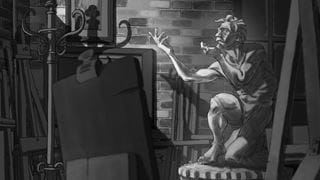
By design
 by Alumni staff – Jun 8, 2018
by Alumni staff – Jun 8, 2018 As technology shifts the needle in journalism, creating new pathways to deliver information, journalists such as Stuart Thompson are using digital tools to delve deeper into stories online and showcase a new style of reporting.
“Text is just one way to tell the story, and often there are better ways. That means using all the tools you have in your toolbox,” says Thompson (Journalism ’06), the graphics director of the New York Times’ Opinion section. “When you try to tell visual stories, you tell different stories.”
At the Times, Thompson leads a team separate from the rest of the newsroom, giving him the freedom to experiment with new formats and ideas, playing with the intersection of words and visuals.
“When hiring me, they said, ‘We need somebody who can define (the section’s) direction without having any of our oversight, but try to hit the quality of our work.’ And I said, ‘That sounds really hard. Let's give it a try’.”
Thompson was hired to the newly created role in April 2017, and nearly one year later the team’s editorial series on domestic violence and gun crime became a Pulitzer Prize finalist.
Thompson and his team’s innovations at the Times have drawn attention from an industry seeking to redefine itself at a time of intense competition and reinvention. One of his first pieces, an interactive look at every lie told by President Donald Trump, won national acclaim. The piece was awarded a Gold Medal from the Society for New Design and landed Thompson a television spot on MSNBC.
“In the journalism industry, you fight a lot to prove that this type of reporting isn’t really different at all from what anyone else is doing,” says Thompson. “It's just we have more tools and tell news stories in different ways. We have the same news values, the same criteria, and want the stories to be just as strong and impactful through original reporting.”
Thompson’s training as a reporter began at Sheridan’s journalism program, where he learned the foundations that would carry him through further studies in media at Western University. When the opportunity came for an internship at the Globe and Mail, Thompson jumped at the chance.
“Because journalism has gone through so much change, it seems like there's a lot of opportunity to find new ways to innovate, and to create new jobs that don't exist, and that's not a thing you can say in every industry. It just takes an entrepreneurial spirit and a bit of elbow grease to realize those ideas.”
Although originally assigned to edit photo galleries along with the other interns, he brought his knowledge of coding and JavaScript to the forefront, eventually leading him to being hired as multimedia editor.
At The Globe, Thompson began exploring different avenues for visual storytelling, including a look at Nelson Mandela’s family tree, federal budget cuts and a “Who Had It Tougher” comparison of young adults today and 30 years ago.
When Thompson heard the Wall Street Journal was expanding its visual reporting team in 2014, he contacted them with his ideas on how he could shape this new direction.
Moving from Toronto to New York to become senior interactive graphics editor at the Journal, Thompson started developing his ideas on how text and graphics could be married in a digital format to drive a new form of layout and reporting. Quickly moving up to a graphics director position after nine months, Thompson ran a department of 30 people combining illustration, design, reporting, data and even cartography into a cohesive and visual way to tell stories online. The graphics team led the visual efforts for the U.S. election and was awarded with a Pulitzer Prize for their contributions to a series of investigative stories on Medicare.
When the New York Times reached out in early 2017, Thompson knew that he was ready to take on a new challenge.
To this day, the desire to find a unique niche, whether for reasons of job security or innovation, continues to drive Thompson forward in an ever-evolving field.
“Because journalism has gone through so much change, it seems like there's a lot of opportunity to find new ways to innovate, and to create new jobs that don't exist, and that's not a thing you can say in every industry,” he says. “It just takes an entrepreneurial spirit and a bit of elbow grease to realize those ideas.”
Media Contact
For media inquiries, contact Sheridan’s Communications and Public Relations team.



